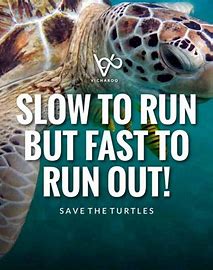Good to know that you are going to continue this journey of saving sea turtles with me! They could be slow at running but are very fast at running out..
Let watch a video to why we need to save them:-
Video on Saving Sea Turtles
Now let me tell you some tips on how to save sea turtles!-
-
Reduce marine debris that may entangle or be accidentally eaten by sea turtles.
-
Participate in coastal clean-ups and reduce plastic use to keep our beaches and ocean clean. Trash in the ocean can harm sea turtles and other creatures that live there.
A single-use plastic bottle found along Texas' shoreline with sea turtle bite markings. Credit Goes to- NOAA
-
Carry reusable water bottles and shopping bags
-
Refrain from releasing balloons, they'll likely end up in the ocean where sea turtles can mistake them for prey and consume them.
-
Keep nesting beaches dark and safe for sea turtles. Turn off, shield, or redirect lights visible from the beach. Lights disorient hatchling sea turtles and discourage nesting females from coming onto the beach to lay their eggs.
-
Do not disturb nesting turtles, nests, or hatchlings. Attend organized sea turtle watches that know how to safely observe nesting sea turtles.
-
Remove recreational beach equipment like chairs, umbrellas, boats at night so sea turtles are not turned away.
-
Fill in holes and knock down sandcastles before you leave the beach. They can become obstacles for nesting turtles or emerging hatchlings.
-
How to Save Sea Turtles on World Sea Turtle Day
Sea turtles are ancient reptiles that have lived in the oceans for over 100 million years, but now they face many threats from human activities.
Human activity over the last few centuries has unfortunately accelerated the process of their endangerment, putting sea turtles at more risk than ever before.
Phenomena such as climate change has also had an adverse effect on sea turtle survival, especially as the effects of climate change have become more pronounced over the years.
Despite this seemingly dim outlook for the future of sea turtles, however, there are still things we can do to help save sea turtles.
SDG INFORMATION-
-
Local marine resources are a very important part of coastal communities in Papua New Guinea and in the Pacific.
Marine resources contribute to local people's livelihood through food, medicine, clothing, spirituality and also income to allow locals to participate in the cash based economy.
In the time of our ancestors there was abundance of life in the sea with very little pressure on them, taking enough only for the daily meal. Because there was low demand for marine resources harvesting methods were restricted to fish traps and fishing lines.
Today we see a different scenario where the demand to take from the marine environment is high, because of population increase and the drive to be part of the cash economy.
We are depleting our marine resources at a faster rate than it can recover and so affecting the very resources that we depend for sustenance. One of the very prehistoric animal is the leatherback turtle (Dermochelys coriacea) which finds it's nesting area in the beaches of Madang.
The villagers of Karkum, Magubem and Kimadi in Sumkar District, and Mur, Yamai, Lalok, Bom-Sagar and Male in the Rai Coast District, Madang, have a traditional attachment to this animal. Leatherback turtles and Green turtles have a special place in the heart of these local people.
Now it is also affected by human settlement and the need to trade also for garden food crops. Therefore a greater threat is being posed on their life. Their nesting areas will be vulnerable to the impacts of climate change through shoreline erosion as well which is something the locals cannot control.
Their migratory routes and habitat have also been threatened by industrial fishing. The recent approval of seabed mining in the Solwara 1, has even paused a greater threat to the turtles and the marine ecological seasons. If nothing is done to conduct research, socio-economic mapping of local communities,
assess and implement Locally Managed Marine Areas to conserve, protect, restore, promote, manage and sustainably use turtles as per the Papua New Guinea's (Fauna Act 1976) and other marine biodiversity and their habitats, the locals will lose a part of their traditional heritage, and also their identity.
The future leaders who are still babies now will not even see or feel a real turtle but only see it in a story book or in the television.Turtles are a migratory species.
They travel through national, regional and international waters to feed and nest.
Efforts to conserve them at the local level must therefore be linked to the national, sub-regional, regional and international level if we are to achieve sustainable and long-term goals to saving turtles.The objective of this partnership is therefore to establish, strengthen cooperation,
enhance and enable genuine and durable partnerships with all stakeholders so that together we can all conserve, and sustainably use our oceans and seas and their resources in light of the Barbados Programme of Action (BPOA) and the Mauritius Strategy for Implementation (MSI) at the sub-national, national, sub-regional and international levels.
